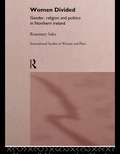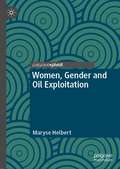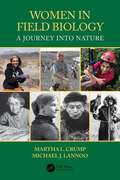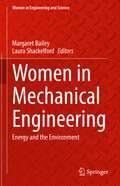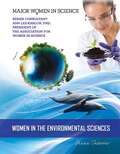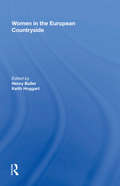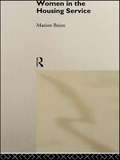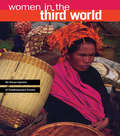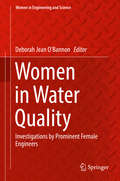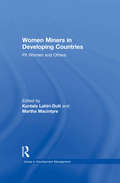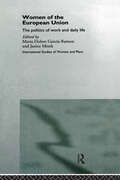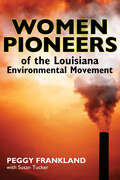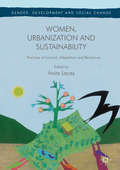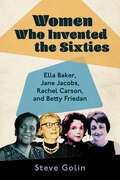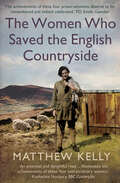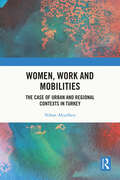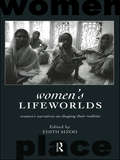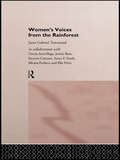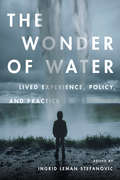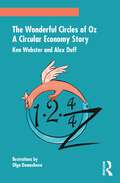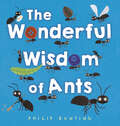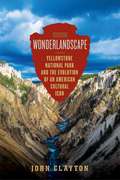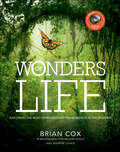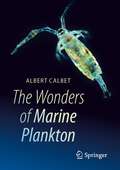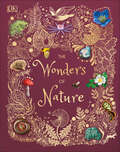- Table View
- List View
Women Divided: Gender, Religion and Politics in Northern Ireland (Routledge International Studies of Women and Place)
by Rosemary SalesThe ongoing Irish peace process has renewed interest in the current social and political problems of Northern Ireland. In bringing together the issues of gender and inequality, Women Divided, a title in the International Studies of Women and Place series, offers new perspectives on women's rights and contemporary political issues. Women Divided argues that religious and political sectarianism in Northern Ireland has subordinated women. A historical review is followed by an analysis of the contemporary scene-- state, market (particularly employment patterns), family and church--and the role of women's movements. The book concludes with an in-depth critique of the current peace process and its implications for women's rights in Northern Ireland, arguing that women's rights must be a central element in any agenda for peace and reconciliation.
Women, Gender and Oil Exploitation (Gender, Development and Social Change)
by Maryse HelbertThis book examines the gender dimensions of large-scale mining in the oil industry and how oil exploitation has produced long-term economic, political, social and environmental risks and benefits in developing countries. It also shows that these risks and benefits have been unequally distributed between women and men. This project maps the ongoing dialogue between women’s issues and resource management, particularly, oil. The author attempts to answer the following questions: What are the impacts of oil projects on women in oil-rich countries? How can these impacts be explained? How can these impacts be reduced?
Women in Field Biology: A Journey Into Nature
by Martha L. Crump Michael J. LannooWomen are contributing to disciplines once the sole domain of men. Field biology has been no different. The history of women field biologists, embedded in a history largely made and recorded by men, has never been written. <p><p>Compilations of biographies have been assembled, but the narrative—their story—has never been told. In part, this is because many expressed their passion for nature as writers, artists, collectors, and educators during eras when women were excluded from the male-centric world of natural history and science. The history of women field biologists is intertwined with men’s changing views of female intellect and with increasing educational opportunities available to women. Given the preponderance of today’s professional female ecologists, animal behaviorists, systematists, conservation biologists, wildlife biologists, restoration ecologists, and natural historians, it is time to tell this story—the challenges and hardships they faced and still face, and the prominent role they have played and increasingly play in understanding our natural world. <p><p> For a broader perspective, we profile selected European women field biologists, but our primary focus is the journey of women field biologists in North America. Each woman highlighted here followed a unique path. For some, personal wealth facilitated their work; some worked alongside their husbands. Many served as invisible assistants to men, receiving little or no recognition. Others were mavericks who carried out pioneering studies and whose published works are still read and valued today. <p><p>All served as inspiration and proved to the women who would follow that women are as capable as men at studying nature in nature. Their legacy lives on today. The 75 female field biologists interviewed for this book are further testament that women have the intellect, stamina, and passion for fieldwork.
Women in Mechanical Engineering: Energy and the Environment (Women in Engineering and Science)
by Margaret Bailey Laura ShackelfordThis book features influential scholarly research and technical contributions, professional trajectories, disciplinary shifts, personal insights, and a combination of these from a group of remarkable women within mechanical engineering. Combined, these chapters tell an important story about the dynamic field of mechanical engineering in the areas of energy and the environment, as seen from the perspective of some of its most extraordinary women scientists and engineers. The volume shares with the Women in Engineering and Science Series the primary aim of documenting and raising awareness of the valuable, multi-faceted contributions of women engineers and scientists, past and present, to these areas. Women in mechanical engineering and energy and the environment are historically relevant and continue to lead these fields as passionate risk takers, entrepreneurs, innovators, educators, and researchers. Chapter authors are members of the National Academies, winners of major awards and recognition that include Presidential Medals, as well as SWE, SAE, ASME, ASEE and IEEE Award winners and Fellows.
Women in the Environmental Sciences (Major Women in Science #10)
by Shaina IndovinoWomen have made major contributions to science throughout history, including in the environmental sciences. Learn about the lives of some of the most amazing women in environmental science, from Rachel Carson to Lena Ma, as well as their exciting and important work. Discover what it takes to work in the environmental sciences. Find out about the opportunities for women in the field. Read Women in the Environmental Sciences to see if following in the footsteps of the many brilliant women who have made their mark in environmental science is something you want to do.
Women in the European Countryside (Perspectives On Rural Policy And Planning Ser.)
by Henry BullerMuch of the literature published so far on gender relations in rural areas has either focused on comparisons of the position of men and women, or explored the position of women given prevailing structural forces and behavioural 'norms' that restrict the autonomy of women as human agents. This groundbreaking book broadens the debate by developing our understanding of how societal processes produce and sustain gender divisions, particularly in rural areas, highlighting aspects of rural women's lives previously invisible in the literature. Illustrated by case studies from France, Germany, Greece, Norway and Sweden, the book examines the critical issues of education and training, entrepreneurship, leadership, limited work and service opportunities, social mobility, and work experiences. In doing so, the contributors provide a fascinating comparative study of both national-regional and broader European realities.
Women in the Housing Service
by Marion BrionThis book explores the contribution of women to the development of housing management in the 20th century. It outlines tactics and strategies of organization and factors which have seemed to help or hinder women's participation in housing. Evidence from statistical sources, historical documents and personal interviews is also assessed. Throughout the discussion, key issues are linked to current trends in the 1990s, making this volume suitable as a source of reference for students and researchers in housing and related fields.
Women in the Third World: An Encyclopedia of Contemporary Issues
by Nelly P. Stromquist Karen MonkmanIdeal for researching the status and activities of Third World womenFor quick, reliable coverage of women's issues in developing countries, here is a concise reference work written by a team of more than 80 international experts. The Encyclopedia comprises 68 essays that cover the entire Third World, from Africa to Asia, from the Near East to South and Central America, from the South Pacific to the Caribbean. The women authors are acknowledged experts from Harvard University, the World Bank, the United Nations Development Fund for Women, the University of Nairobi, the International Labor Organization, and other institutions, who summarize the most recent scholarship on a wide range of important subjects. Thoroughly indexed and cross-referenced, the Encyclopedia is an ideal starting point for in-depth research in such areas as:recent developments in the prevention of violence against women * the conditions of women's lives across regions and countries * women's participation in government, science, and technology * hidden curriculum issues in higher education * an overview of women's experiences as small-scale entrepreneursA feminist viewpoint enhances the coverageInformed throughout by a feminist perspective, the Encyclopedia focuses on traditional women's concerns, such as political participation, human rights, nutrition, housework, the family, equality, health, and more. But the coverage also extends to such issues as domestic and sexual violence, creation of women-friendly cities, patriarchal ideologies as religious beliefs, the needs of older women, new jobs and exploitation in industrial production, AIDS, the gender consequences of ecological devastation, movements for change, and other areas of increasing awareness. Geographical entries cover all the major regions and countries and discuss conditions and issues in each area.Spotlights the newest and best sourcesThe Encyclopedia brings together information that has been widely scattered in sources from many disciplines. An introduction by the editor illuminates the most important issues faced by Third World women today and analyzes the drastically changed global situation and how the changes impacted on the material presented in the Encyclopedia.Reference aids make information retrieval easyAn annotated bibliography of the latest and most important sources, as well as a reference list at the end of each chapter, provide quick access to current literature. A thorough name and subject index makes it easy to pinpoint information.Special FeaturesOffers articles by recognized scholars and activists on gender and developmental issues * Presents a variety of perspectives by women from both industrialized and developing countries * Summarizes the literature of established disciplines, bringing together important material scattered in many sources * Identifies new areas for research affecting gender and development in emerging fields, such as legal rights * Outlines strategies for action in such critical areas as ecology and urban issues * An annotated bibliography and list of references at end of each chapter make it easy to expand your research
Women in Water Quality: Investigations by Prominent Female Engineers (Women in Engineering and Science)
by Deborah Jean O’BannonThis volume captures the impact of women’s research on the public health and environmental engineering profession. The volume is written as a scholarly text to demonstrate that women compete successfully in the field, dating back to 1873. Each authors’ chapter includes a section on her contribution to the field and a biography written for a general audience. This volume also includes a significant representation of early women’s contributions, highlighting their rich history in the profession. The book covers topics such as drinking water and health, biologically-active compounds, wastewater management, and biofilms. This volume should be of interest to academics, researchers, consulting engineering offices, and engineering societies while also inspiring young women to persist in STEM studies and aspire to academic careers.Features a blend of innovations and contributions made by women in water quality engineering, as well as their path to success, including challenges in their journeysPresents an opportunity to learn about the breadth and depth of the field of water qualityIncludes a history of women in water quality engineering as well as research in current issues such as urban water quality, biologically-active compounds, and biofilms
Women Miners in Developing Countries: Pit Women and Others (Voices in Development Management)
by Martha MacintyreContrary to their masculine portrayal, mines have always employed women in valuable and productive roles. Yet, pit life continues to be represented as a masculine world of work, legitimizing men as the only mineworkers and large, mechanized, and capitalized operations as the only form of mining. Bringing together a range of case studies of women miners from past and present in Asia, the Pacific region, Latin America and Africa, this book makes visible the roles and contributions of women as miners. It also highlights the importance of engendering small and informal mining in the developing world as compared to the early European and American mines. The book shows that women are engaged in various kinds of mining and illustrates how gender and inequality are constructed and sustained in the mines, and also how ethnic identities intersect with those gendered identities.
Women of the European Union: The Politics of Work and Daily Life (Routledge International Studies of Women and Place)
by Maria Dolors Garc Janice MonkWomen of the European Union challenges gender-blind assessments of the economic and social aspects of the European Union policies to examine the real implications of Union for the diversity of women in the Member States.The authors also analyze how women's work and daily lives are shaped by local and national policies, by local and global economic conditions, and by diverse and changing cultural values.Detailed contemporary case studies explore how place comes together with class, life stage, sexuality and ethnicity to affect the way in which women are constrained and how they develop strategies to manage their lives.
Women Pioneers of the Louisiana Environmental Movement
by Peggy FranklandWomen Pioneers of the Louisiana Environmental Movement provides a window into the passion and significance of thirty-eight committed individuals who led a grassroots movement in a socially conservative state. The book is comprised of oral history narratives in which women activists share their motivation, struggles, accomplishments, and hard-won wisdom. Additionally interviews with eight men, all leaders who worked with or against the women, provide more insight into this rich--and also gendered--history.The book sheds light on Louisiana and America's social and political history, as well as the national environmental movement in which women often emerged to speak for human rights, decent health care, and environmental protection. By illuminating a crucial period in Louisiana history, the women tell how "environmentalism" emerged within a state already struggling with the dual challenges of adjusting to the civil rights movement and the growing oil boom.Peggy Frankland, an environmental activist herself since 1982, worked with a team of interviewers, especially those trained at Louisiana State University's T. Harry Williams Center for Oral History. Together they interviewed forty women pioneers of the state environmental movement. Frankland's work also was aided by a grant from the Louisiana Endowment for the Humanities. In this compilation, she allows the women's voices to provide a clear picture of how their smallest actions impacted their communities, their families, and their way of life. Some experiences were frightening, some were demeaning, and many women were deeply affected by the individual persecution, ridicule, and scorn their activities brought. But their shared victories reveal the positive influence their activism had on the lives of loved ones and fellow citizens.
Women, Urbanization and Sustainability
by Anita LaceyThis work considers the city as a gendered space and examines women’s experiences and engagement in both urbanization and sustainability. Such a focus offers distinctive insights into the question of what it means for a city to be sustainable, asking further how sustainability needs to work with gender and the gendered lives of cities’ inhabitants. Vitally, it considers women’s lives in cities and their work to forge more sustainable cities through a wide variety of means, including governmental, non-governmental and local grassroots and individual efforts towards sustainable urban life. The volume is transnational, offering case-studies from a wide range of city sites and sustainability efforts. It explores crucial questions such as the gendered nature and women’s experiences of current urbanization; the gendered nature of urban sustainability thinking and programmes; and local alternatives and resistances to dominant modes of addressing urbanization challenges.
Women Who Invented the Sixties: Ella Baker, Jane Jacobs, Rachel Carson, and Betty Friedan
by Steve GolinWhile there were many protests in the 1950s—against racial segregation, economic inequality, urban renewal, McCarthyism, and the nuclear buildup—the movements that took off in the early 1960s were qualitatively different. They were sustained, not momentary; they were national, not just local; they changed public opinion, rather than being ignored. Women Who Invented the Sixties tells the story of how four women helped define the 1960s and made a lasting impression for decades to follow. In 1960, Ella Baker played the key role in the founding of the Student Nonviolent Coordinating Committee, which became an essential organization for students during the civil rights movement and the model for the antiwar and women’s movements. In 1961, Jane Jacobs published The Death and Life of Great American Cities, changing the shape of urban planning irrevocably. In 1962, Rachel Carson published Silent Spring, creating the modern environmental movement. And in 1963, Betty Friedan wrote The Feminine Mystique, which sparked second-wave feminism and created lasting changes for women. Their four separate interventions helped, together, to end the 1950s and invent the 1960s.Women Who Invented the Sixties situates each of these four women in the 1950s—Baker’s early activism with the NAACP and the Southern Christian Leadership Conference, Jacobs’s work with Architectural Forum and her growing involvement in neighborhood protest, Carson’s conservation efforts and publications, and Friedan’s work as a labor journalist and the discrimination she faced—before exploring their contributions to the 1960s and the movements they each helped shape.
The Women Who Saved the English Countryside
by Matthew KellyA vibrant history of English landscape preservation over the last 150 years, told through the lives of four remarkable women In Britain today, a mosaic of regulations protects the natural environment and guarantees public access to green spaces. But this was not always so. Over the last 150 years, activists have campaigned tirelessly for the right to roam through the countryside and the vital importance of preserving Britain&’s natural beauty. Matthew Kelly traces the history of landscape preservation through the lives of four remarkable women: Octavia Hill, Beatrix Potter, Pauline Dower, and Sylvia Sayer. From the commons of London to the Lake District, Northumberland, and Dartmoor, these women protected the English landscape at a crucial period through a mixture of environmental activism, networking, and sheer determination. They grappled with the challenges that urbanization and industrial modernity posed to human well-being as well as the natural environment. By tirelessly seeking to reconcile the needs of particular places to the broader public interest they helped re-imagine the purpose of the English countryside for the democratic age.
Women, Work and Mobilities: The case of urban and regional contexts in Turkey
by Nihan AkyelkenThis book explores the wider implications of how workers move within and across cities and regions to reach economic opportunities. It does so with a specific focus on women in urban and regional contexts in Turkey. The book reveals specificities and generalisations about mobility patterns of women in low-income households/low-paid jobs and how these change in the existence of urban and regional interventions, such as industrial zoning, urban transformations and mobility restrictions. The book presents new theorisations of work and mobility through labour agency, showing how mobility changes the recruitment and use of labour under state interventions. It orchestrates the existing narratives of containment, mobility and rootedness to shed light on the role of labour agency in organising livelihoods. The book particularly acknowledges the multiscale, multifaceted and relational nature of mobilities entailed in the economy by bringing the role of labour agency into urban and regional contexts. This book will appeal to researchers and students working on labour geography, feminist geography, mobilities and urban studies.
Women's Lifeworlds: Women's Narratives on Shaping their Realities
by Edith SizooWomen's Lifeworlds explores the diversity and complexity of women's perceptions and reactions to their own 'lifeworlds' in their own words. Examining the changing meaning of 'place' in women's lives over time and across space, this book questions how women face, negotiate and shape the social space of their environment. Engaging personal narratives are presented by fifteen women of various age groups, from different cultural, religious, social and geographical backgrounds, from Mexican politician, Muslim psychiatrist, Finnish housewife to Indian guru and African rural woman. Writing about the lives of their grandmothers, mothers, themselves, their daughters or other close female relatives, the authors of these life narratives cross generational and cultural divides and share perceptions with each other. This unique inter-generational approach provides an engaging challenge to the generalised assumptions of how women in various historical and cultural contexts feel about womanhood, life, society, culture and religion.
Women's Voices from the Rainforest (Routledge International Studies of Women and Place)
by Janet Gabriel TownsendWomen's Voices from the Rainforest explores the position of the women whose families are tearing down the rainforest. These women of Central and Latin America have been largely invisible until now, but they are at last turning their voices into action.International development policy and its top-down culture must take much of the blame for environmental and social destruction of the rainforest. Presenting the contrasting results of different methodologies, a comprehensive literature review, and the voices of the rainforest women themselves, told in life histories, the authors argue for the adoption of "grassroots" strategies, not international solutions.
The Wonder of Water: Lived Experience, Policy, and Practice (G - Reference, Information And Interdisciplinary Subjects Ser.)
by Ingrid Leman StefanovicFacing droughts, floods, and water security challenges, society is increasingly forced to develop new policies and practices to cope with the impacts of climate change. From taken-for-granted values and perceptions to embodied, existential modes of engaging our world, human perspectives impact decision-making and behavior. The Wonder of Water explores how human experience – from embodied cultural paradigms to value systems and personal biases – impact decisions around water. In many ways, the volume expands on the growing field of water ethics to include questions around environmental aesthetics, psychology, and ontology. And yet this book is not simply for philosophers. On the contrary, a specific aim is to explore how more informed philosophical dialogue will lead to more insightful public policies and practices. Case studies describe specific architectural and planning decisions, fisheries policies, urban ecological restorations and more. The overarching phenomenological perspective, however, means that these discussions emerge within a sensibility toward the foundational significance of human embodiment, culture, language, worldviews, and, ultimately, moral attunement to place.
The Wonderful Circles of Oz: A Circular Economy Story
by Ken Webster Alex DuffWith the world’s economies impacted by coronavirus, billions are feeling social, environmental, and economic injustices. The call for a new, more just, more distributive economic story and system is louder and more urgent than ever. The Wonderful Circles of Oz provides both the framework and solutions for navigating towards an effective circular economy – the gateway to an abundant, autonomous, and democratic future. Widely regarded as one of the world’s most engaging circular economy thought leaders, Ken Webster, together with creative writer, Alex Duff, use a storytelling approach based on The Wonderful Wizard of Oz to offer a new, accessible, and compelling narrative about the future direction of our economy. ‘The harder you work, the more you’ll improve your lot.’ That’s the simple story we’ve been sold over the last 40 years to justify how today’s economy works. Yet extreme inequality, the devastation of our natural world, and the erosion of our communities tell us this economic story resembles a work of fiction and the way our extractive economy operates is not fit for purpose. Still a restoration narrative, a satisfying story about our future and how we’ll get there, is slow to emerge. Using allegory, commentary, and reflection, this book helps speed the shift from an extractive economy of materials, energy, and finance to one based on an effective circular economy, which builds wealth as a stock of solutions accessible to all. The Wonderful Circles of Oz goes beyond tired debates (capital vs labour and market vs state) and blends fiction and non to effectively communicate the need for macro-economic system redesign. Exploring complex change and containing echoes of modern monetary theory, this book is a must for business professionals, students, and anyone with an interest in the circular economy.
The Wonderful Wisdom of Ants
by Philip BuntingTake a peek under the rock, and discover what we can learn from the world of the ant, in this delightful blend of nonfiction and inspirational humor by author-illustrator Philip Bunting!There are ten quadrillion ants in the world, and yet I bet you never thought they could teach you anything. But these tiny creatures can do big things when they work together--just like people!With his signature humor and graphic illustrations, Philip Bunting delivers facts, laughs, and heart all in this special book that teaches that the answers to many of life&’s biggest questions can be found in your own back yard (once you&’re ready to look).
Wonderlandscape: A Cultural History Of Yellowstone National Park
by John ClaytonAn evocative blend of history and nature writing that tells the story of Yellowstone’s evolving significance in American culture through the stories of ten iconic figures. Yellowstone is America's premier national park. Today is often a byword for conservation, natural beauty, and a way for everyone to enjoy the great outdoors. But it was not always this way. Wonderlandscape presents a new perspective on Yellowstone, the emotions various natural wonders and attractions evoke, and how this explains the park's relationship to America as a whole. Whether it is artists or naturalists, entrepreneurs or pop-culture icons, each character in the story of Yellowstone ends up reflecting and redefining the park for the values of its era. For example, when Ernest Thompson Seton wanted to observe bears in 1897, his adventures highlighted the way the park transformed from a set of geological oddities to a wildlife sanctuary, reflecting a nation was concerned about disappearing populations of bison and other species. Subsequent eras added Rooseveltian masculinity, democratic patriotism, ecosystem science, and artistic inspiration as core Yellowstone hallmarks. As the National Park system enters its second century, Wonderlandscape allows us to reflect on the values and heritage that Yellowstone alone has come to represent—how it will shape the America's relationship with her land for generations to come.
Wonders of Life: Exploring the Most Extraordinary Phenomenon in the Universe (Wonders Series)
by Brian Cox Andrew CohenIn Wonders of Life: Exploring the Most Extraordinary Force in the Universe, the definitive companion to the Discovery Science Channel series, Professor Brian Cox takes us on an incredible journey to discover the most complex, diverse, and unique force in the universe: life itself.Through his voyage of discovery, international bestselling author Brian Cox explains how the astonishing inventiveness of nature came about and uncovers the milestones in the epic journey from the origin of life to our own lives, with beautiful full-color illustrations throughout. From spectacular fountains of superheated water at the bottom of the Atlantic to the deepest rainforest, Cox seeks out the places where the biggest questions about life may be answered: What is life? Why do we need water? Why does life end?Physicist and professor Brian Cox uncovers the secrets of life in the most unexpected locations and in the most stunning detail in this beautiful full-color volume.
The Wonders of Marine Plankton
by Albert CalbetMarine plankton, despite their tiny size, are crucial for the functioning of marine food webs. It is not just about one organism eating another; when this happens, it helps release the nutrients accumulated within living matter, making them available again for microalgae. Plankton are present in freshwater and in all the seas and oceans on the planet. Moreover, they are responsible for supporting life on Earth and has provided us (on geological timescales) with a significant portion of the oxygen we breathe. In just a small spoonful of seawater, we can find around fifty million viruses, five million bacteria, hundreds of thousands of small unicellular flagellates, thousands of microscopic algae, five heterotrophic ciliates or dinoflagellates, and, with some luck, a small crustacean like copepods. This book aims to bridge the gap between scientific research and the general public, offering a captivating exploration of the fascinating world of marine plankton. Through engaging narratives and visually compelling illustrations, readers will gain insights into the importance of plankton in marine ecosystems, their diverse forms, and the crucial role they play in maintaining our planet's health.
The Wonders of Nature (DK Children's Anthologies)
by Ben HoareUncover awe-inspiring stories behind the natural world with this nature book for curious kids aged 6-8.The world is filled with curious objects such as amazing rocks and minerals, microscopic life, plants, animals and more. The wonders of wildlife are so much bigger than young minds can fathom and there is always more to learn! The Wonders of Nature is a stunning nature encyclopedia for young readers to explore, with reference pages packed with fascinating information, little learners will be captivated as they dive into this collection of 100 remarkableitems from the natural world, from orchids to opals and lichens to lizards and so much more! Each plant, animal, and rock is shown both photographically and illustrated, and children will love poring over the detailed close-up images. The storybook descriptions let you discover the myths and legends surrounding both organisms and gemstones, as well as key facts about their natural history. Find out how the prowling jaguar uses spots to avoid being spotted, why a sticky sundew means big trouble for insects, and what on Earth a radiolarian is. This beautiful treasury lets you find the things that interest you and uncover new favourites along the way. With reference pages packed with information you&’ll go away knowing something you didn&’t before, and you&’ll return time and again. The Wonders of Nature takes you on a tour of our planet through commonplace-but-incredible objects made by nature itself. The engaging storybook-style descriptions and simple text shed a light on the wonders of nature and wildlife, making this book ideal for inquisitive children aged 6-8 who loves to spot things when exploring outside and wants to know more about the wonderful and mysterious natural world.Celebrate your child&’s curiosity as they:- Explore 100 minerals, plants, and animals each with a stunning photographs and illustrations- Reveal fun facts in visual index guides that provide key reference information - Uncover captivating information on the natural history and mythology of a variety of nature&’s wonders This nature encyclopedia for children is the perfect blend of storybook style text with out of this world illustrations which makes it a fantastic nature book for children who are obsessed with wildlife and the natural world. Encourage young readers to go on a journey to explore a world of information, making this the ideal first reference book for kids aged 6-8 to enjoy for hours on end, whether reading with the family or reading alone, this fun fact book also doubles up as the perfect gift for curious kids who love to learn. Explore the vastness of space by uncovering: -Stunning Jacket Detail: gold foil, holographic foil & metallic gold edges-Striking photography & illustrations inside-A beautiful book for the whole family to treasure -A quality gift to be passed down through the generationsMore in the SeriesThe Wonder&’s of Nature is part of the beautiful and informative Anthology series. Complete the series and nurture your child's curiosity as they explore the natural world with Nature&’s Treasures or let them walk with the dinosaurs who ruled the earth before them in Dinosaurs and other Prehistoric Life.
